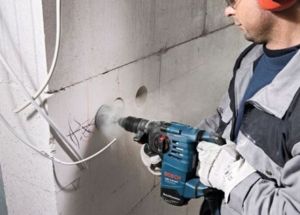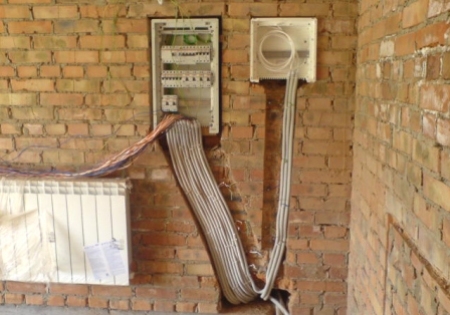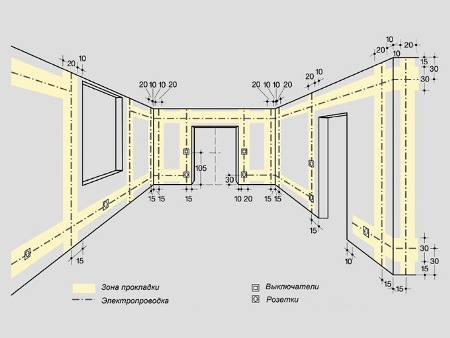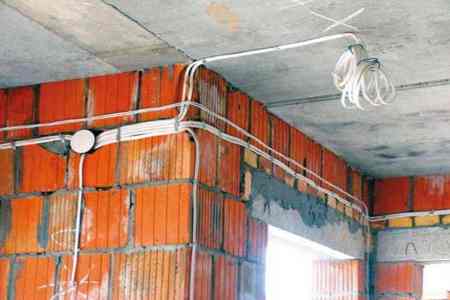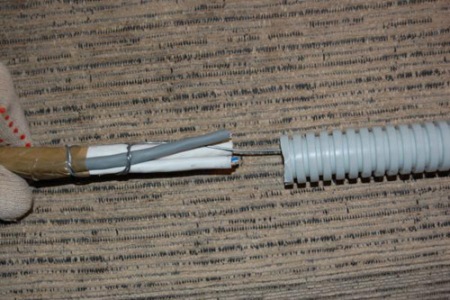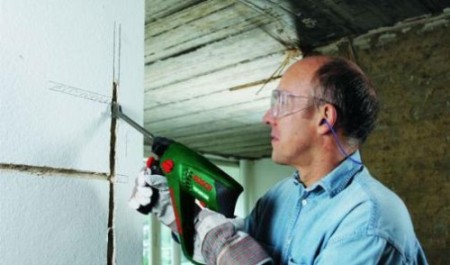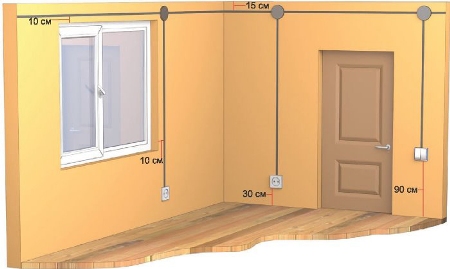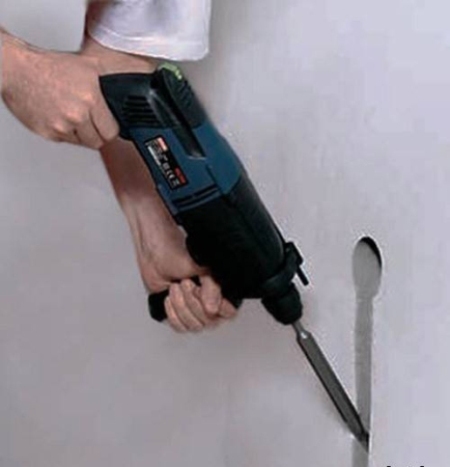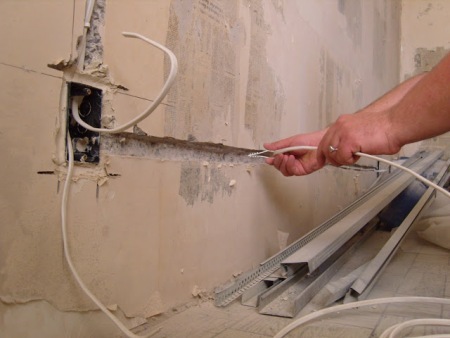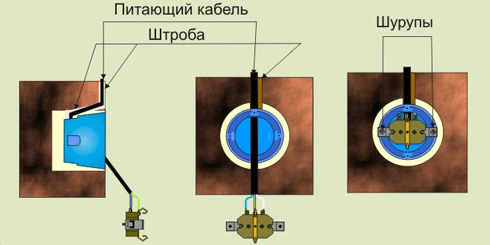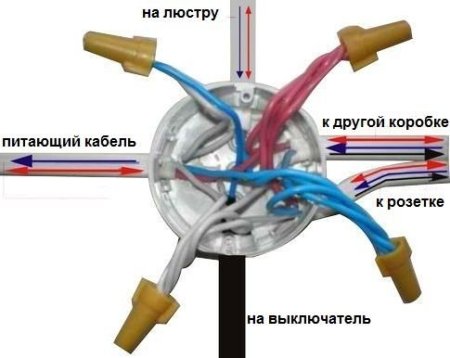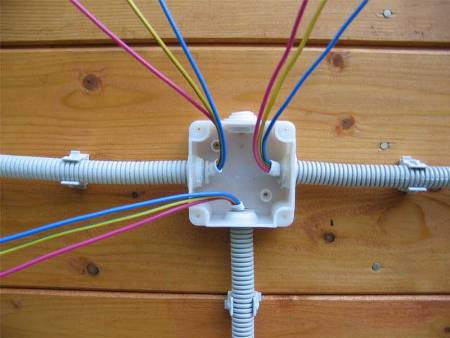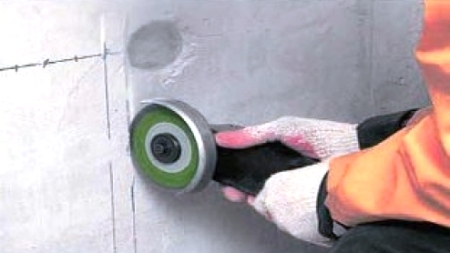The increase in people's well-being, the increase in material incomes and the desire to live and raise children in a more comfortable environment has led to a real boom in suburban private construction. The main building material remains brick, strong, reliable and environmentally friendly. Naturally, building a house is not only the erection of walls and roofing, it is also the arrangement of complex engineering systems, one of the most important among them is the power supply system.
Content
- 1 Wiring options
- 2 How to make wiring in the house for plastering
- 3 Installation of electrical wiring in a brick house - what cables should be used
- 4 Wiring in the house with your own hands - a step-by-step instruction for placing wires in accordance with the rules
- 5 Wiring in the house with your own hands - how to properly make stitches
- 6 Features of drawing up of schemes of electroconducting
- 7 What tools and materials will be needed to complete the work?
Wiring options
Since most often there is brick construction of single-storey and multi-storey houses, it makes sense to consider in detail how the electrical wiring in a brick house is arranged.
There is not much difference in whether the wiring is installed in a private house or in an apartment of a brick high-rise building, the main difference is a more complicated scheme that will need to be built when electrifying a private house: electricity will need to be supplied to more rooms, as well as to the local area . Internal wiring in the brick house of the house can be made in two ways:
- open, involving the laying of an electric cable in special plastic boxes along the surface of the walls,
- closed, performed under the plaster.
Naturally, the first method is rarely used, except in the back rooms - it negatively affects the aesthetics of the interior. The installation of a closed wiring may have features that depend on how and from which materials the interior finish of the room is performed.
How to make wiring in the house for plastering
Installation of electrical wiring for plastering is the simplest option, for successful performance of work it will be enough to carefully attach all the necessary wires to the brick walls, naturally, before the beginning of the finishing works. As fasteners recommended to use plastic clips. Route the cable strictly in accordance with the designed circuits.
In order to connect all kinds of electrical appliances in the house, you will also need to install sockets, for their installation, you will need the sub-boxes. Since the adjectives should not spoil the appearance of the wall, they will need to be drowned in the thickness of the wall. The depth of the location is determined taking into account the thickness of the plaster, a drill is required to make holes. Fix the installation boxes with alabaster.
Before the plastering works also the installation of junction boxes is carried out. Mount them in each room, in the same way as the podzoetniki, in the middle of them will be laid padded electric cables.
Installation of electrical wiring in a brick house - what cables should be used
For high-quality electrical wiring, it is recommended to use NYM or VVG copper-coated copper cables covered with non-flame-retardant PVC, their use eliminates the risk of fire in the event of a short circuit, nor is the tendency of the shell to release a large amount of toxic smoke in the event of a fire. If the installation is made of AWV, PVA, PV wires, the installation is carried out in pipes or ducts.
For pulling the cable in the pipe an elastic plastic broach is used:
- first stretch the pipe in the tube,
- to it the end of a cable is fixed,
- then pull the electric cable into the pipe.
Experts recommend that you make the installation of a hidden electrical wiring of the house in plastic pipes fixed to the walls. The main convenience of this option is the possibility of replacing the wiring without dismantling the old system - it will be enough to take out the old cable and to stretch the new one into the pipe, it will not be necessary to trowel the walls. To plaster walls can proceed after laying all the wires, the installation of boxes, distribution and installation. Naturally, the layer of plaster in this case should exceed the thickness of the laid cables.
If it is planned to apply a thin layer of plaster to the walls, then there will be nowhere to hide the cables - a way out of the situation is laying in the walls of special channels called strobes. Uncomplicated in the implementation will be the option with the facing of the walls with plasterboard. In this case, the wires, pipes or ducts are fixed to the walls with the help of plastic brackets, installation of a gypsum card will securely hide all engineering communications. Specialists recommend that when doing wiring in this way, do not violate the rules of electrical installation and lay the power supply system in accordance with the scheme.
Wiring in the house with your own hands - a step-by-step instruction for placing wires in accordance with the rules
The wire laying scheme should provide for a strictly vertical or horizontal position. The wires can be laid diagonally only in the attic room, with the proviso that the cable will be laid parallel to the ceiling line.
Perform a horizontal laying of a hidden type is recommended at a distance of 0.3 m from the floor or 0.3 m below the level of overlappings. If necessary, the cable can be laid slightly higher, but in such a way that the distance from it to the ceiling was about 0.15 m. But ideally, all the same should be guided by 0.3 m, this will prevent trouble in the installation of suspended ceilings.
Wiring in the house with your own hands - how to properly make stitches
The method of laying electric cables for plaster or plasterboard is usually used in new buildings. If the wiring changes during the repair of the old house or apartment, then without stucco plastering will not work.
Since the old electrical wiring is hidden under the plaster layer, it is necessary to make channels of the appropriate dimensions for laying a new one so that they can drown cables or pipes for placing cables. If the layer of plaster is thick enough, then only the layer of plaster will have to be shtrobed. This option is simpler, when you make a groove in the plaster apply special efforts will not be required. Significantly worse, if you need to lay a groove in a brick wall. But if you still have to trowel the brick, you should not forget that the width and depth of the groove should not exceed 25 mm. The length of each shtroby should not exceed three meters.
It is not allowed to equip horizontal channels on load-bearing walls. Strokit on the ceiling you can only plaster, but in no case - overlap. Do not run the channels in such a way that in the interval between switches, switch boxes and sockets, multiple angles form - they should be as much smaller. Ideally, only one angle should be formed in the transition between the horizontal and vertical channels. In this case, the joints of the walls do not take into account.
For work it is possible to use a perforator, impact drill, Bulgarian, ordinary hammer and chisel, or a more modern device - shtroborez. It will allow you to quickly build a flat groove of the desired width and depth. Perform strokes according to a scheme drawn up according to all rules.
- Work begins with the marking of the walls, on which draw lines of cable laying. It will be two parallel lines coming out from the switch boxes and the lamps, sockets, switches that go to the place of location.
- You can not proceed to the job until you have checked for de-energizing all the existing wiring - only such a measure will be able to completely protect the working person.
- Since a lot of dust will form when working with a puncher or other stabbing devices, you will need to protect yourself by wearing protective goggles, a respirator, or at least a gauze mask, gloves.
- When working with a puncher, it is recommended to use a shovel, wide and short borax. First of all, a drill is installed in the perforator, holes are made along the entire length of the groove. Their maximum depth is 25 mm, the distance between the holes is about 15 mm. Next, install a shovel, with its help remove fragments of plaster or brick. It is not recommended to locate the blade transversely to the stroba - this can lead to chipping of pieces much larger than required.
- When working with a Bulgarian, you need a diamond disk, you need to cut two cuts, at both ends of the strobes.
- Remove the unnecessary plaster between the cuts with a perforator. Using the bulgark can do the job much faster, but the dust formation while doing so will be more active. Ideal option will be cleaning the dust with a powerful vacuum cleaner - the tube which the assistant should hold.
- An undeniable advantage is the shtoborez - it works two parallel lines of the canal at the same time. Of course, for a qualitative work performance, diamond disks are also required. The second advantage of the shtoborez is the ability to work without dust. After preparing the channels, they are cleaned of dust and treated with a primer.
- Similarly arrange the location of distribution and installation boxes. After fixing the boxes to the alabaster, you can proceed to install the wires.
- The cables can be laid directly in the strobes and covered with plaster, or inserted into the placed recesses of the tube. Fastening of pipes and cables is carried out with the help of alabaster, struts or staples.
- Upon completion of the cable laying, the grooves are sealed with the stucco mixture.
Features of drawing up of schemes of electroconducting
Immediately note that the drawing up of the wiring diagram is mandatory, the drawn up scheme should be submitted to the appropriate bodies of electrical supervision for approval. Therefore, when drawing up the scheme, certain rules should be taken into account, we mentioned them above.
Experts recommend that when designing, there should be at least two separate branches:
- for powering lighting devices, is carried out with a wire with a cross section of 1.5 mm2
- to supply voltage to the sockets, when laying it, a cable with a cross-section of at least 2.5 mm2 should be used.
- For more powerful devices, such as boilers, washing machines, etc. you should create separate branches.
Junction boxes must be installed in each room. If necessary, pull the wires through the wall:
- in it make a hole,
- insert a metal sleeve,
- on the edges of the sleeve, sleeves are made of plastic
- extend the wire.
What tools and materials will be needed to complete the work?
Before you begin, you should prepare the following materials:
- cable of the required cross-section,
- alabaster,
- terminals,
- mounting brackets,
- plastic bushings,
- metal sleeves.
When laying the wiring, you will need to use the following tools:
- hammer,
- side-cutters,
- pliers,
- chisel,
- with a mounting knife,
- screwdrivers,
- multimeter,
- voltage indicator.
If the preparation for the work is carried out correctly, then there should not be any special problems during the installation. After laying the cable according to the scheme, after the completion of the laying of all the branches, they are connected, then the measuring work is performed.


